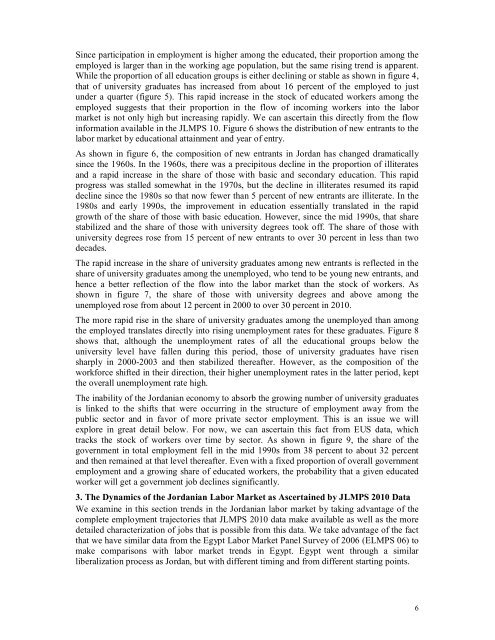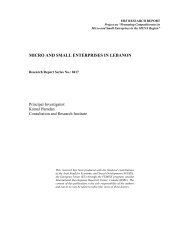The Structure and Evolution of Employment in Jordan - University of ...
The Structure and Evolution of Employment in Jordan - University of ...
The Structure and Evolution of Employment in Jordan - University of ...
Create successful ePaper yourself
Turn your PDF publications into a flip-book with our unique Google optimized e-Paper software.
S<strong>in</strong>ce participation <strong>in</strong> employment is higher among the educated, their proportion among theemployed is larger than <strong>in</strong> the work<strong>in</strong>g age population, but the same ris<strong>in</strong>g trend is apparent.While the proportion <strong>of</strong> all education groups is either decl<strong>in</strong><strong>in</strong>g or stable as shown <strong>in</strong> figure 4,that <strong>of</strong> university graduates has <strong>in</strong>creased from about 16 percent <strong>of</strong> the employed to justunder a quarter (figure 5). This rapid <strong>in</strong>crease <strong>in</strong> the stock <strong>of</strong> educated workers among theemployed suggests that their proportion <strong>in</strong> the flow <strong>of</strong> <strong>in</strong>com<strong>in</strong>g workers <strong>in</strong>to the labormarket is not only high but <strong>in</strong>creas<strong>in</strong>g rapidly. We can ascerta<strong>in</strong> this directly from the flow<strong>in</strong>formation available <strong>in</strong> the JLMPS 10. Figure 6 shows the distribution <strong>of</strong> new entrants to thelabor market by educational atta<strong>in</strong>ment <strong>and</strong> year <strong>of</strong> entry.As shown <strong>in</strong> figure 6, the composition <strong>of</strong> new entrants <strong>in</strong> <strong>Jordan</strong> has changed dramaticallys<strong>in</strong>ce the 1960s. In the 1960s, there was a precipitous decl<strong>in</strong>e <strong>in</strong> the proportion <strong>of</strong> illiterates<strong>and</strong> a rapid <strong>in</strong>crease <strong>in</strong> the share <strong>of</strong> those with basic <strong>and</strong> secondary education. This rapidprogress was stalled somewhat <strong>in</strong> the 1970s, but the decl<strong>in</strong>e <strong>in</strong> illiterates resumed its rapiddecl<strong>in</strong>e s<strong>in</strong>ce the 1980s so that now fewer than 5 percent <strong>of</strong> new entrants are illiterate. In the1980s <strong>and</strong> early 1990s, the improvement <strong>in</strong> education essentially translated <strong>in</strong> the rapidgrowth <strong>of</strong> the share <strong>of</strong> those with basic education. However, s<strong>in</strong>ce the mid 1990s, that sharestabilized <strong>and</strong> the share <strong>of</strong> those with university degrees took <strong>of</strong>f. <strong>The</strong> share <strong>of</strong> those withuniversity degrees rose from 15 percent <strong>of</strong> new entrants to over 30 percent <strong>in</strong> less than twodecades.<strong>The</strong> rapid <strong>in</strong>crease <strong>in</strong> the share <strong>of</strong> university graduates among new entrants is reflected <strong>in</strong> theshare <strong>of</strong> university graduates among the unemployed, who tend to be young new entrants, <strong>and</strong>hence a better reflection <strong>of</strong> the flow <strong>in</strong>to the labor market than the stock <strong>of</strong> workers. Asshown <strong>in</strong> figure 7, the share <strong>of</strong> those with university degrees <strong>and</strong> above among theunemployed rose from about 12 percent <strong>in</strong> 2000 to over 30 percent <strong>in</strong> 2010.<strong>The</strong> more rapid rise <strong>in</strong> the share <strong>of</strong> university graduates among the unemployed than amongthe employed translates directly <strong>in</strong>to ris<strong>in</strong>g unemployment rates for these graduates. Figure 8shows that, although the unemployment rates <strong>of</strong> all the educational groups below theuniversity level have fallen dur<strong>in</strong>g this period, those <strong>of</strong> university graduates have risensharply <strong>in</strong> 2000-2003 <strong>and</strong> then stabilized thereafter. However, as the composition <strong>of</strong> theworkforce shifted <strong>in</strong> their direction, their higher unemployment rates <strong>in</strong> the latter period, keptthe overall unemployment rate high.<strong>The</strong> <strong>in</strong>ability <strong>of</strong> the <strong>Jordan</strong>ian economy to absorb the grow<strong>in</strong>g number <strong>of</strong> university graduatesis l<strong>in</strong>ked to the shifts that were occurr<strong>in</strong>g <strong>in</strong> the structure <strong>of</strong> employment away from thepublic sector <strong>and</strong> <strong>in</strong> favor <strong>of</strong> more private sector employment. This is an issue we willexplore <strong>in</strong> great detail below. For now, we can ascerta<strong>in</strong> this fact from EUS data, whichtracks the stock <strong>of</strong> workers over time by sector. As shown <strong>in</strong> figure 9, the share <strong>of</strong> thegovernment <strong>in</strong> total employment fell <strong>in</strong> the mid 1990s from 38 percent to about 32 percent<strong>and</strong> then rema<strong>in</strong>ed at that level thereafter. Even with a fixed proportion <strong>of</strong> overall governmentemployment <strong>and</strong> a grow<strong>in</strong>g share <strong>of</strong> educated workers, the probability that a given educatedworker will get a government job decl<strong>in</strong>es significantly.3. <strong>The</strong> Dynamics <strong>of</strong> the <strong>Jordan</strong>ian Labor Market as Ascerta<strong>in</strong>ed by JLMPS 2010 DataWe exam<strong>in</strong>e <strong>in</strong> this section trends <strong>in</strong> the <strong>Jordan</strong>ian labor market by tak<strong>in</strong>g advantage <strong>of</strong> thecomplete employment trajectories that JLMPS 2010 data make available as well as the moredetailed characterization <strong>of</strong> jobs that is possible from this data. We take advantage <strong>of</strong> the factthat we have similar data from the Egypt Labor Market Panel Survey <strong>of</strong> 2006 (ELMPS 06) tomake comparisons with labor market trends <strong>in</strong> Egypt. Egypt went through a similarliberalization process as <strong>Jordan</strong>, but with different tim<strong>in</strong>g <strong>and</strong> from different start<strong>in</strong>g po<strong>in</strong>ts.6

















